I have fixed length text files that I have to import into SQL Server daily. These files contain header records (01) and Detail records (02). I am trying to build an SSIS package to do this. I have a script component that splits the data out but I cant get it to work. I am new to SSIS …please help.
Here is sample data:
01CA0022-0002 I0000000002618
02 AJ -000000000000375626 -0000000000003
02 AJ -000000000000372226 -00000000000037
02 AJ -000000000000738726 -00000000000073
using System;
using System.Data;
using Microsoft.SqlServer.Dts.Pipeline.Wrapper;
using Microsoft.SqlServer.Dts.Runtime.Wrapper;
[Microsoft.SqlServer.Dts.Pipeline.SSISScriptComponentEntryPointAttribute]
public class ScriptMain : UserComponent
{
public override void PreExecute()
{
base.PreExecute();
}
public override void PostExecute()
{
base.PostExecute();
}
public override void Input0_ProcessInputRow(Input0Buffer Row)
{
if (Row.Line.Substring(0, 2) == "01")
{
HeaderBuffer.AddRow();
HeaderBuffer.NAME_EDC = Row.Line.Substring(231, 60);
HeaderBuffer.DUNS_EDC = Row.Line.Substring(291, 13);
}
else if (Row.Line.Substring(0, 2) == "02")
{
DetailBuffer.AddRow();
DetailBuffer.REC_TYPE_DTEAIL = Row.Line.Substring(1, 2);
DetailBuffer.PMT_NUMBER = Row.Line.Substring(3, 6);
DetailBuffer.PMT_ACTION_CD = Row.Line.Substring(9, 2);
DetailBuffer.PMT_AMOUNT = Row.Line.Substring(11, 18);
DetailBuffer.ADJUSTMENT_CD = Row.Line.Substring(29, 2);
DetailBuffer.ADJ_AMOUNT = Row.Line.Substring(31, 18);
DetailBuffer.ACCT_EDC = Row.Line.Substring(49, 50);
DetailBuffer.ACCT_OLD_EDC = Row.Line.Substring(99, 50);
DetailBuffer.NO_ACCT_EGS = Row.Line.Substring(149, 30);
DetailBuffer.PMT_POST_DATE = Row.Line.Substring(179, 8);
DetailBuffer.XREF_NUMBER = Row.Line.Substring(187, 30);
DetailBuffer.UNDISCOUNTED_AMOUNT = Row.Line.Substring(217, 18);
DetailBuffer.DISCOUNT_ADJUSTMENT_AMOUNT = Row.Line.Substring(235, 18);
DetailBuffer.INVOICE_ADVICE_NUMBER = Row.Line.Substring(253, 30);
}
}
public override void CreateNewOutputRows()
{
}
}
The error I get says:
Error at Data Flow Task [Script Component [85]]: The binary code for the script is not found. Please open the script in the designer by clicking Edit Script button and make sure it builds successfully. Error at Data Flow Task [SSIS.Pipeline]: "Script Component" failed validation and returned validation status "VS_ISBROKEN". Error at Data Flow Task [SSIS.Pipeline]: One or more component failed validation. Error at Data Flow Task: There were errors during task validation


Best Answer
Instead of using a script component, I recommend using a more database-centric approach.
Consider the following approach:
EntireRow.InputRowNumberfield. TheInputRowNumberis helfpul for debugging.InputFlatFilecontaining theInputRowNumber int, andEntireRow varchar(max)fields.InputFlatFilestaging table into your real database. Based on your example data, these queries should be fairly straight forward.I think the database-centric approach is better for the following reasons:
FileLogtable and insert a row at the start of the control flow with logging information like file name, modified date, etc. Retain a reference to theInputRowNumberandFileLogIDin the destination database and you can trace the data from source file to destination easily.